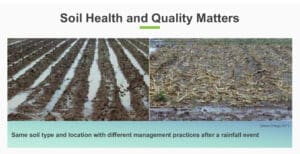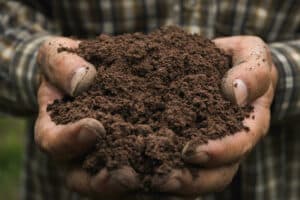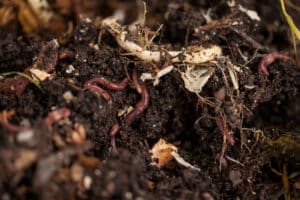Apr 11, 2025

When it comes to water, growers are hoping for a Goldilocks situation. You don’t want your farms to be too wet, and you don’t want your farms to be too dry; they need to be just right. But, how often your moisture levels are considered ‘just right’ largely depends on two variables.
You can’t control the weather. But, you can control the second variable – your soil health.
Soil health and water productivity are closely intertwined. Healthy soil supports a healthy water cycle and vice versa. These two things together are the foundation of a productive, resilient agriculture industry.
Supporting your soil health is an investment to make the water you have go further and maintain or achieve consistent and higher yield potentials.

Healthy soil is more resilient soil – regardless of weather fluctuations. Healthy soil:
To help your soil achieve these benefits, you’ll need a soil management plan that takes into account the chemical, biological and physical components of soil.
Soil health is the interaction between organisms, their environment and the results of these interactions. Simply put, it’s the biological integrity of your soil. For example, earthworms interact with soil, and depending on how compact it is, are either able to tunnel through the soil – creating pores for water. Or, the soil is too compact and they’re unable to create beneficial pores for water storage.
The healthier your soil, the higher the chances of withstanding weather variability. That includes everything from higher than average levels of precipitation to prolonged seasonal drought.
The functionality of soil health is greatly influenced by soil organic matter, an important part of soil composition that influences soil’s physical, biological and chemical functions.
Soil quality refers to how well soil functions physically, biologically and chemically, or how well it does its ‘job’.

The physical aspect of soil health is the structure and texture of your soil. It’s influenced by the type of soil you have and your makeup of sand, silt, peat and clay.
Your soil’s physical structure is integral to its ability to hold water. The better the soil structure, the better the infiltration; so your soil can take in water when it rains, and retain that water for plants to access when water is scarce.
You can examine the physical health of your soil by looking at:
When you’re able to improve aggregation and soil structure, you can reduce soil erosion and compaction. How well your soil retains water is greatly impacted by the soil pore size distribution (creating both micropores and macropores) and soil structure. This is how your soil particles are grouped together into aggregates, and bound together by a physical, chemical, or biological process or a mix of these processes.
The biological integrity of your field includes living and non-living biology in your fields – everything from the measure of the microbial population and diversity to decaying roots to organic matter. The biology in your soil provides the foundation for soil to function properly and contribute to crop production and quality.
Biology commonly found in healthy soil include:
The abundance and diversity of the biology in your soil can make a big impact on your water productivity. This biology allows soil to take in, store, and deliver water to plants. Organic matter plays a foundational role in soil health and water productivity. It allows soil to form stable aggregates – or soil particles that stick together.
The sturdy aggregates, made of sand, silt, clay and organic matter, create pores to store water. For every 1% increase in organic matter, US croplands could store the amount of water that flows over Niagara Falls in 150 days.
Adding to the structure created by organic matter, earthworms, arthropods, and decaying roots create macropores that water flows into. These act as water storage in your fields for your crops.
Beneficial bacteria in your soil secrete exopolysaccharides (EPS), or a glue-like substance. These glues help stick soil particles together, creating stronger aggregates to allow water infiltration. Mycorrhizal fungi also hold soil in place through hyphal growth creating wide-spanning nets in soil to tie soil particles together, reducing erosion.
These are just some of the ways biology can impact your soil’s ability to filter and store water.
The chemical aspects of your soil health is essential for supporting your soil biology and your crops. Some ways to look at your soil health from a chemical point of view include:
Most crops have specific nutrient requirements, with soil pH being the exception. When soils are too acidic (pH < 5.5) or too alkaline (pH > 8.0) it can create poor soil structure and reduced aggregation. This, in turn, impacts water infiltration and storage.
When you improve the chemical health of your soil, you also improve your soil’s fertility.

To determine how healthy your soil is, consider getting a soil test and working with a trusted crop advisor to make changes to your field as needed. A soil test can measure the chemical, physical and biological makeup of your soil, including:
You can also ask yourself some of the following questions to get an understanding of how healthy your soil is:
Soil health is at the core of productive, sustainable agriculture. Investing in your soil health is essential to secure the long-term future for any farm.

There are two key things to consider when looking at the relationship between soil health and water. Healthy soil not only holds water, but it can also get rid of water when there’s too much of it in your fields.
Healthy soil improves water retention and reduces the dependency or need for irrigation. Water infiltration allows water to filter past the surface of your soil and prevent runoff.
Healthy soils hold more water, so they’re able to sustain plant life and replenish groundwater. This creates resilient farms and healthier ecosystems. Also, the more water that can percolate through the soil, the less runoff, reducing flooding. Deep infiltration increases aquifer levels by recharging underlying groundwater supplies.
Healthy soil also mitigates erosion. By keeping your soil from washing away, it also keeps it out of local bodies of water, avoiding sedimentation and potential contamination.
When your soil is able to hold more water, and for longer periods of time; you may be able to lengthen time between irrigation cycles or reduce water applied per irrigation. This improves your overall return-on-investment.
When your soil is healthy and can retain more water, your crops are more resilient against abiotic stressors. The less stressed your crops are, the higher likelihood of improved yield potential, which could lead to bigger harvests and better returns.
Healthy soil makes the most of the water available in your community. It replenishes aquifers, reduces leaching and mitigates sediment runoff. This leaves cleaner water for all the people around you.
The four pillars for managing or improving your soil health are maximizing the living roots in your soil, maximizing soil cover, maximizing biodiversity and minimizing disturbance. These practices can also be paired with the 4R principle. Apply the right source, at the right rate, at the right time and in the right place of your fertilizer inputs.
From feeding your cash crops to holding your soil in place, cover crops help maximize soil cover. They have been shown to, “decrease, or almost completely eliminate erosion from agricultural fields, increase rainfall infiltration to the soil layer, keep nutrients like nitrogen and phosphorus in place and prevent the loss of these nutrients to vulnerable waterways, and increase soil organic matter.”
On average, cover crops reduce sediment losses from erosion by 20.8 tons per acre of conventional tilled fields, 6.5 tons per acre on reduced tilled fields and 1.2 tons on no-till fields. And, as mentioned earlier, their decaying roots act as water storage for cash crops in your field – increasing infiltration.
While nitrogen can be lost due to runoff water and groundwater, cover crops reduce nitrogen losses by an average of 48%. Cover crops also scavenge for nitrogen, making it available for your cash crops as a slow-nutrient release.
Crop rotation, like cover crops, maximizes soil coverage by strategically planning which crops will be planted in each location of your field year over year. Diversifying plant types contributes to overall health and resilience of soil. To improve water retention, growers can consider crops with different root structures, like deep vs. shallow roots. This will help with the aeration of your soil.
Some other benefits also include preventing nutrient depletion and breaking pest cycles.
The amount of organic matter in your soil plays a large role in how healthy your soil is, and how well it manages water. The more organic matter that’s in your soil, the more likely it is to act as a sponge and retain water for your crops to access. This is because organic matter improves aggregate binding, pore structure, and aeration.
High levels of organic matter also improve infiltration, reducing runoff and erosion.
If your soil is low on organic matter, consider adding compost, wood chips, green manure, and crop residue
While no grower enjoys dealing with pesky stubble, continuous tillage can have a negative impact on your soil health. Continuous and repeated tillage destroys soil aggregates and the nets and glues created by microbes that hold soil aggregates together. As pores collapse, your soil can become compacted and will struggle to hold water.
If your fields are already compact, you may consider tillage as a way to mix organic matter into your soil to improve your soil structure. However, this isn’t a practice that should be repeated year after year, if possible.
Remember the beneficial soil microbes we mentioned earlier that create nets and glues in your soil? Unfortunately 75% of soil microbes in farm soils are either starving or dormant. They need support from growers so they can support your soil and crops.
Consider feeding them a carbon-rich microbe food like PhycoTerra. It’s not a plant fertilizer, but rather a superior food source made from microalgae that stimulates rapid growth of beneficial soil microbes.

Compacted soil has a hard time holding onto any water. Instead of penetrating through the soil, it hits the topsoil and then runs off the surface crust, as seen above. By supporting microbes, growers can see improved penetration and infiltration of moisture events, recharging the root zone and storing away water.

The pore space created by sturdy aggregates as a result of an active microbiome creates longer term storage of soil moisture in pore spaces as water fills around aggregates. Soil particles are also able to hold onto films of water that crops can access, when needed.
All of the previously mentioned practices also increase microbial activity.
Yes, supporting beneficial microbes can improve soil health, regardless of the soil’s composition. Active soil microbes, which increases EPS and fungal growth, will lead to improved soil aggregation.
The untreated sample appears on the left. You can see improved results with just 4 quarts of PhycoTerra, but even greater results were achieved with 12 quarts (3 gallons). While this test specifically used PhycoTerra Organic, both products offer the same benefits.
Applied at 1 quart per acre, PhycoTerra has produced notable yield improvements for corn, soybean and wheat. Some of which include:
A carbon-rich microbial food supports your soil microbes, so these beneficial microbes can improve your soil health and water productivity, and promote higher yield potentials.
You can review results for other crops, like potatoes, cotton, barley and more in our trial dashboard.
Protecting our farms for generations to come starts with protecting our soils today. Healthy soil is one of the best tools to help crops adapt to hotter, more drought prone climates. It also helps a grower’s bottom line, as it increases water productivity.
The better your soil can manage water, the higher your potential yields. Whether you decide to feed your soil microbes, reduce tillage, or implement a cover crop on your farm, or combining multiple practices all of these practices can be a step in the right direction to healthier soil.
Think the soil microbes in your field could use some support? Ready to find out what type of yields feeding microbes on your farm achieve? Fill out a contact form to learn more about PhycoTerra.
Note: All trial data is current as of blog posting. For the most up to date trail data, please visit our trials page.